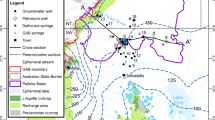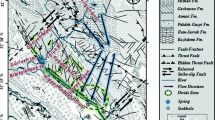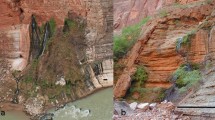Abstract
Artesian springs support important wetland ecosystems comprising highly specialised, endemic animal and plant species. Understanding the hydrogeological processes that sustain springs is critical to their management and characterisation of the connected groundwater system. This paper focuses on the springs of the Eulo and Bourke supergroups in the south-central part of the Great Artesian Basin in Queensland and New South Wales, Australia. These springs have been heavily impacted by aquifer drawdown, as a result of uncontrolled discharge of artesian water from pastoral bores. This study uses a stratigraphic model of the aquifer and aquitard sediments, a model of the potentiometric surface, existing information on the coverage of basement and surface structures, and a comprehensive field survey of all known springs to identify the association of springs with the edge of the geological basin, basement outcrop, basement highs, surface and deep basement faults, and a thinned aquitard. Many springs in the Eulo Supergroup are associated with basement highs and many springs are associated with deep faults, suggesting that reactivation of these faults may be an important cause of spring discharge. Springs in the Bourke Supergroup previously thought to be outcrop springs (gravity-fed), by virtue of their surface characteristics, are more likely to be artesian springs based on the interpretation of basement geology, surface faults and water chemistry, which align most closely to the Hooray Sandstone, the artesian aquifer underlying the springs.
Résumé
Des sources artésiennes soutiennent d’importants écosystèmes de zones humides comprenant des espèces animales et végétales endémiques hautement spécialisées. Comprendre les processus hydrogéologiques qui soutiennent les sources est essentiel pour leur gestion et la caractérisation du système connexe d’eau souterraine. Le présent article est axé sur les sources des Supergroupes de Eulo et de Bourke, situés dans la partie centre-sud du Grand Bassin Artésien dans le Queensland et en Nouvelles Galles du Sud, Australie. Ces sources ont été fortement impactées par le rabattement dans l’aquifère qui résulte d’une décharge incontrôlée de l’eau artésienne à partir des puits pastoraux. L’étude utilise un modèle stratigraphique des dépôts sédimentaires de l’aquifère et de l’aquitard, un modèle de la surface de la charge hydraulique, l’information existante sur les terrains de couverture du socle et les structures de surface, et un suivi de terrain exhaustif de toutes les sources connues, afin d’identifier leurs liens avec les limites du bassin géologique, avec les affleurements, les pointements, les failles de surface et les failles profondes du socle, et avec un amincissement de l’aquitard. Beaucoup de sources du Supergroupe de Eulo sont associées à des pointements du socle et de nombreuses sont associées à des failles profondes, ce qui suggère que la réactivation de ces failles peut être une cause importante de la diminution du débit de la source. Les sources du Supergroupe de Bourke, considérées précédemment comme des sources d’affleurement (alimentées gravitairement), sur la base de leurs caractéristiques de surface, sont d’après l’interprétation de la géologie du socle, des failles de surface et de la chimie de l’eau, davantage susceptibles d’être des sources artésiennes très étroitement liées aux Grès de Hooray, l’aquifère artésien sous-jacent aux sources.
Resumen
Los manantiales artesianos sustentan importantes ecosistemas de humedales con especies de plantas y animales endémicos altamente especializados. La identificación de los procesos hidrogeológicos que sustentan los manantiales es fundamental para su gestión y la caracterización del sistema de aguas subterráneas asociado. Este artículo se centra en los manantiales de los supergrupos Eulo y Bourke, situados en la parte centro-sur de la Great Artesian Basin de Queensland y Nueva Gales del Sur (Australia). Estos manantiales se han visto fuertemente afectados por la depresión del acuífero, como resultado de la descarga incontrolada de agua artesiana procedente de las perforaciones rurales. Este estudio utiliza un modelo estratigráfico del acuífero y de los sedimentos del acuitardo, un modelo de la superficie potenciométrica, la información existente sobre la cubierta de basamento y de las estructuras superficiales, y un amplio estudio de campo de todos los manantiales conocidos para identificar la asociación de los manantiales con el borde de la cuenca geológica, el afloramiento, los altos, las fallas superficiales y profundas del basamente, y un delgado acuitardo. Muchos manantiales del Supergrupo Eulo están asociados a los altos del basamento y otros están asociados a las fallas profundas, lo que sugiere que la reactivación de estas fallas puede ser una causa importante de la descarga de los manantiales. Los manantiales del Supergrupo Bourke que anteriormente se consideraban manantiales de afloramiento (alimentados por la gravedad), en virtud de sus características superficiales, es más probable que sean manantiales artesianos en base a la interpretación de la geología del subsuelo, las fallas superficiales y la química del agua, que se alinean más estrechamente con la arenisca Hooray, el acuífero artesiano subyacente a los manantiales.
摘要
自流泉支撑着重要的湿地生态系统, 其中包括极其特别的地方性动植物物种。了解维系泉水的水文地质过程对于与之相关的地下水系统的管理和特征化至关重要。本文重点介绍了澳大利亚昆士兰州和新南威尔士州大自流盆地中南部的Eulo和Bourke超群泉水。由于从牧民井的自流泉自然排泄, 这些泉水主要受到含水层降深的影响。本研究使用了含水层和隔水层沉积物的地层模型, 测压管液面模型, 有关洞室和表面结构覆盖的现有信息, 以及所有已知泉的综合野外调查, 以期识别泉水与地质盆地边缘、地下露头、洞室高度、表层和深层地下断层以及变薄的隔水层的关系。Eulo超群中的许多泉水与基底高度有关, 而且许多泉水与深部的断层有关, 这表明这些断层的重新激活可能是释放泉水的重要原因。Bourke超群中的泉水以前认为是由于地表特征的出露型泉水(重力控制), 现在更可能是由于基底地质、地表断层和水化学解释的自流泉, 其与泉水下伏的Hooray砂岩的自流含水层相近。
Resumo
Fontes artesianas sustentam importantes ecossistemas de áreas úmidas que compreendem espécies animais e vegetais endêmicas altamente especializadas. Compreender os processos hidrogeológicos que sustentam as nascentes é fundamental para a sua gestão e caracterização do sistema de água subterrânea conectado. Este artigo enfoca as nascentes dos Supergrupos Eulo e Bourke na parte centro-sul da Grande Bacia Artesiana em Queensland e Nova Gales do Sul, Austrália. Essas nascentes foram fortemente impactadas pelo rebaixamento do aquífero, como resultado da descarga descontrolada de água artesiana de poços pastorais. Este estudo usa um modelo estratigráfico do aquífero e sedimentos de aquitardo, um modelo da superfície potenciométrica, informações existentes sobre a cobertura de estruturas de embasamento e superfície e um levantamento de campo abrangente de todas as nascentes conhecidas para identificar a associação de nascentes com a borda da bacia geológica, afloramento do embasamento, alturas do embasamento, falhas superficiais e profundas do embasamento e um aquitardo desbastado. Muitas nascentes no Supergrupo Eulo estão associadas a elevações do embasamento e muitas nascentes estão associadas a falhas profundas, sugerindo que a reativação dessas falhas pode ser uma causa importante de descarga das nascentes. As nascentes do Supergrupo Bourke, anteriormente consideradas afloramentos (alimentadas pela gravidade), em virtude de suas características de superfície, são mais prováveis de serem nascentes artesianas com base na interpretação da geologia do embasamento, falhas de superfície e química da água, que se alinham mais intimamente com o Arenito Hooray, o aquífero artesiano subjacente às nascentes.










Similar content being viewed by others
References
Abbott WE (1881) Notes of a journey on the Darling. J Proc R Soc New South Wales 15:41–70
Aldam R, Kuang KS (1989) An investigation of structures controlling natural discharge of artesian waters in the southwestern Great Artesian Basin. Q Geol Notes Geol Surv South Aust 109:2–9
DERM (2005) Hydrogeological framework report for the Great Artesian Basin Water Resource plan area: version 1.0. Queensland Department of Natural Resources and Mines, Brisbane, Australia
Dixon O, Hodgkinson J (2011) The base of the Wallumbilla Formation in the Eromanga, Surat, Carpentaria and Laura Basins: regional correlation of a key stratigraphic surface, the C-Horizon. Record 2011/04, Geological Survey of Queensland, Brisbane, Australia
Doublier MP, Purdy DJ, Hegarty R, Nicoll MG, Zwingmann H (2018) Structural elements of the southern Thomson Orogen (Australian Tasmanides): a tale of megafolds. Aust J Earth Sci 65:943–966. https://doi.org/10.1080/08120099.2018.1526213
Edmunds WM (2004) Silent springs. Groundwater mechanisms under threat. In: Trotter J, Slack P (eds) Managing water resources: past and present. Oxford University Press, Oxford, pp 13–34
Exon NF (1976) Geology of the Surat Basin in Queensland. Bureau of Mineral Resources Bulletin 166. Australian Government Publishing Service, Canberra
Fairfax RJ, Fensham RJ (2002) In the footsteps of J. Alfred Griffiths: a cataclysmic history of Great Artesian Basin springs in Queensland. Aust Geogr Stud 40:210–230
Fairfax RJ, Fensham RJ (2003) Great Artesian Basin springs in southern Queensland 1911–2000. Mem Queensl Museum 49:285–293
Fatchen T (2001) Vegetated wetland area as an index of mound spring flows. In: Proceedings 4th Mound Spring Researchers Forum, Adelaide, Australia, pp 5–8
Fensham RJ, Fairfax RJ (2003) Spring wetlands of the Great Artesian Basin, Queensland, Australia. Wetl Ecol Manag 11:343–362
Fensham RJ, Fairfax RJ, Sharpe PR (2004) Spring wetlands in seasonally arid Queensland: floristics, environmental relations, classification and conservation values. Aust J Bot 52:583–595
Fensham RJ, Ponder WF, Fairfax RJ (2010) Recovery plan for the community of native species dependent on natural discharge of groundwater from the Great Artesian Basin. Department of the Environment, Water, Heritage and the Arts, Canberra, Australia
Fensham RJ, Silcock JL, Powell OC, Habermehl MA (2016) In search of lost springs: a protocol for locating active and inactive springs. Groundwater 54:374–383
Flook S, Fawcett J, Cox R, Pandey S, Schöning G, Khor J, Singh D, Suckow A, Raiber M (2020) A multidisciplinary approach to the hydrological conceptualisation of springs in the Surat Basin of the Great Artesian Basin (Australia). Hydrogeol J 28:219–236. https://doi.org/10.1007/s10040-019-02099-5
GABCC (2000) Great Artesian Basin strategic management plan. Great Artesian Basin Consultative Council, Canberra
Geological Survey of Queensland (2010) Queensland Petroleum Exploration Data (QPED) database. https://data.gov.au/dataset/ds-dga-2fc93ab2-cce9-4e2d-b4b6-b7ab46a941d0/details. Accessed 25 September 2011
Geoscience Australia (2013a) Hydrogeology. https://www.ga.gov.au/scientific-topics/water/groundwater/gab/data/hydrogeology. Accessed 6 June 2020
Geoscience Australia (2013b) Great Artesian Basin major geological structural elements (GABWRA). Bioregional Assessment Source Dataset. https://data.gov.au/data/dataset/8dbe0a37-408a-4458-b4cb-fb896b830cc5. Accessed 6 June 2020
Habermehl MA (1980) The Great Artesian Basin, Australia. BMR J Aust Geol Geophys 5:9–38
Habermehl MA (1982) Springs in the Great Artesian Basin, Australia: their origin and nature. Report 235, Bureau of Mineral Resources, Geology and Geophysics, Canberra
Habermehl M (2001) Wire-line logged water bores in the Great Artesian Basin, Australia: digital data of logs and water bore data acquired by AGSO. Australian Geological Survey Organisation Bulletin 245, AGSO, Canberra
Habermehl MA (2020a) Review: the evolving understanding of the Great Artesian Basin (Australia), from discovery to current hydrogeological interpretations. Hydrogeol J 28:13–36. https://doi.org/10.1007/s10040-019-02036-6
Habermehl MAR (2020b) Hydrogeological overview of springs in the Great Artesian Basin. Proc R Soc Queensl 126:29–46
Habermehl MA, Lau JE (1997) Hydrogeology of the Great Artesian Basin, Australia. 1:2 500 000 map. Australian Geological Survey Organisation, Canberra
Harris C (2002) Culture and geography: South Australia’s mound springs as trade and communication routes. Hist Environ 18:8–11
Hasegawa T, Nakata K, Mahara Y, Habermehl MA, Oyama T, Higashihara T (2016) Characterization of a diffusion-dominant system using chloride and chlorine isotopes (36Cl, 37Cl) for the confining layer of the Great Artesian Basin, Australia. Geochim Cosmochim Acta 192:279–294. https://doi.org/10.1016/j.gca.2016.08.002
Hayashi T, Tokunaga T, Aichi M, Shimada J, Taniguich M (2009) Effects of human activities and urbanization on groundwater environments: an example from the aquifer system of Tokyo and the surrounding area. Sci Total Environ 407:3165–3172
Hinds M (2011) NSW Great Artesian Basin internal data set. Released to Geoscience Australia in 2011 by NSW Office of Water, Sydney
Inverarity K, Heinson G, Hatch M (2016) Groundwater flow underneath mound spring tufas from geophysical surveys in the southwestern Great Artesian Basin, Australia. Aust J Earth Sci 63:857–872. https://doi.org/10.1080/08120099.2016.1261942
Keppel M, Wohling D, Love A, Gotch T (2020a) Hydrochemistry highlights potential management issues for aquifers and springs in the Lake Blanche and Lake Callabona region, South Australia. Proc R Soc Queensl 126:1–25
Keppel MN, Karlstrom K, Crossey L, Love AJ, Priestley S (2020b) Evidence for intra-plate seismicity from spring-carbonate mound springs in the Kati Thanda–Lake Eyre region, South Australia: implications for groundwater discharge from the Great Artesian Basin. Hydrogeol J 28:297–311. https://doi.org/10.1007/s10040-019-02049-1
Kresic N (2010) Types and classifications of springs. In: Kresic N, Stevanovic Z (eds) Groundwater hydrology of springs: engineering, theory, management and sustainability. Elsevier, Amsterdam, pp 31–64
Powell O, Silcock J, Fensham R (2015) Oases to oblivion: the rapid demise of springs in the south-eastern Great Artesian Basin, Australia. Groundwater 53:171–178
Purdy DJ, Hegarty R, Doublier MP (2018) Basement geology of the southern Thomson Orogen. Aust J Earth Sci 65:893–916. https://doi.org/10.1080/08120099.2018.1453547
Ransley T, Radke B, Kellett J, Bell J, Stewart G (2014) Great Artesian Basin - Cadna-owie hooray potentiometric surface. Bioregional Assessment Source Dataset. Geoscience Australia, Canberra
Ransley TR, Radke B, Feitz A, Kellett JR, Owens R, Bell J, Stewart G, Carey H (2015) Hydrogeological atlas of the Great Artesian Basin. Geoscience Australia, Canberra
Roach IC, McPherson AA, Clarke JDA, Brodie RC, Doublier MP, Armistead SE, Skirrow RG, Main PT (2015) The Southern Thomson Orogen VTEMplus AEM Survey: using airborne electromagnetics as an UNCOVER application. Record 2015/029, Geoscience Australia, Canberra
Rossini RA, Fensham RJ, Stewart-Koster B, Gotch T, Kennard MJ (2018) Biogeographical patterns of endemic diversity and its conservation in Australia’s artesian desert springs. Divers Distib 24:1199–1216
Senior BR (1971) Explanatory notes on the Eulo geological sheet. Bureau of Mineral Resources, Geology and Geophysics, Canberra
Senior and Assoc. (1997) Geoscience Australia internal data set and contour interpretations by Senior B. Senior and Assoc., Canberra
Senior BA, Mond A, Harrison PL (1978) Geology of the Eromanga Basin. Bulletin no. 167. Bureau of Mineral Resources, Geology and Geophysics, Canberra
Silcock J, Powell O, Drimer J, Fensham R (2013) Ecological and hydrogeological survey of the Great Artesian Basin Springs: Springsure, Eulo, Bourke and Bogan River supergroups—volume 1: history, ecology and hydrogeology. Commonwealth of Australia, Canberra, 235 pp
Silcock JL, Macdermott H, Laffineur B, Fensham RJ (2016) Obscure oases: natural, cultural and historical geography of western Queensland’s tertiary sandstone springs. Geogr Res 54:187–202
Smart J, Grimes K, Doutch HF, Pinchin J (1980) The Mesozoic Carpentaria Basin and Cainozoic Karumba Basin, north Queensland. Bureau of Mineral Resources Bulletin 202. BMR, Canberra
Smerdon BD, Ransley TR, Radke BM, Kellett JR (2012) Water resource assessment for the Great Artesian Basin. A report to the Australian Government from the CSIRO Great Artesian Basin Water Resource Assessment. CSIRO, Canberra
Stevens LE, Schenk ER, Springer AE (2020) Spring ecosystem classification. Ecol Appl 31(2). https://doi.org/10.1002/eap.2218
Wilson N, Tickle P, Gallant J, Wilson N, Tickle P, Inskeep Cl (2011) 1 second SRTM Derived Hydrological Digital Elevation Model (DEM-H) version 1.0. https://researchdata.edu.au/1-second-srtm-version-10/1278475. Accessed March 2021
Wolaver BD, Priestley SC, Crossey LJ, Karlstrom KE, Love AJ (2020) Elucidating sources to aridland Dalhousie Springs in the Great Artesian Basin (Australia) to inform conservation. Hydrogeol J 28:279–296. https://doi.org/10.1007/s10040-019-02072-2
Acknowledgements
We thank the landholders for access to the sites and Steve Flook for his insightful feedback on the manuscript. Brian Senior provided geological advice. Tim Ransley is especially thanked for a rigorous review of a previous version of this study that prompted a major reanalysis. Ian Pike has been an important local contact and informant for many years.
Author information
Authors and Affiliations
Corresponding author
Additional information
Publisher’s note
Springer Nature remains neutral with regard to jurisdictional claims in published maps and institutional affiliations.
Appendix
Appendix
Rights and permissions
About this article
Cite this article
Fensham, R.J., Doyle, T., Habermehl, M.A. et al. Hydrogeological assessment of springs in the south-central Great Artesian Basin of Australia. Hydrogeol J 29, 1501–1515 (2021). https://doi.org/10.1007/s10040-021-02335-x
Received:
Accepted:
Published:
Issue Date:
DOI: https://doi.org/10.1007/s10040-021-02335-x




